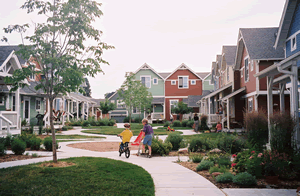More than Cohousing – Cohousing Like and other Alternative Housing Solutions – what’s the difference?

One emerging goal for cohousing is how cohousing can be used as a model for unique needs. There is often debate or confusion about communities that are “Cohousing-like”.
** Cohousing-like takes aspects of cohousing but is not cohousing.
** More-than-cohousing are cohousing-like communities with a social or economic mission.
It is difficult to talk about “More than cohousing” without touching on the topic of “cohousing-like” communities and asking “Is it cohousing”? When is something cohousing, when is it something else, and when is it more than cohousing?
Cohousing values and characteristics improve any community and aspects of cohousing can benefit people with unique needs. We need all sorts of cooperative, collaborative, community-oriented housing of which cohousing is one type.
The purpose of this document is to help identify the characteristics that define cohousing, and clarify terminology for “cohousing–like” or “more-than-cohousing” type communities. Using correct vocabulary is important to prevent the dilution of ideas and concepts.
Definitions / Distinctions
Cohousing
You can go to www.cohousing.org and see the most current consensus driven definition of cohousing: Visit
What is Cohousing? Also helpful is the glossary of terms: Visit Cohousing Glossary
For evaluation purposes consider the following:
Cohousing involves aspects of: (1) Design and (2) Intentional Community with Shared Governance.
Design includes the creation of a physical environment that maximizes the opportunity for humans to encounter each other, which will in turn maximize the opportunity for human interaction and the creation of community. This includes private homes (which affords privacy) and fairly extensive, shared community space and infrastructure. A typical feature is a common house for residents to gather together and share meals. Resident participation in the design is optimal. Most cohousing communities comprise 20-40 households.
Intentional Community – Cohousing communities include the concept that all residents agree to be good neighbors. Other common characteristics include self-governance and management, individual economic investment and independent incomes (as opposed to communes and subsidized housing), and the opportunity to participate in community-building activities such as common meals and conflict resolution. Cohousing cultivates a culture of caring and sharing that involves neighbors supporting each other.
The term Cohousing is a contraction of collaborative and cooperative and housing. The “co” suggest working with others.
Historically, most cohousing was developed with future residents actively involved. Group-initiated development involves individuals coming together to establish how they will work and live as a community. They find and secure land, they engage various professionals (architects, developers and builders), and collectively participate in the design and development of the community in which they will all live. This way of developing cohousing requires the highest level of personal involvement in real estate development. Once moved in, all residents collaborate on the management of their community.
Cohousing-like
This is a term used to describe a neighborhood / housing development that incorporates some, but not all, of the aspects of cohousing design, social intention or management. Many mission-driven housing developers have looked to the cohousing model specifically with regards to pedestrian-friendly design and extensive common facilities as a way to further their mission to provide supportive housing, while retaining outside the community management. (see below for examples)
Commune
A group of people living together and sharing income, possessions and responsibilities. Cohousing is not a commune. Cohousing does not involve shared incomes.
Cooperative (or co-op)
A Co-op is a form of legal real estate ownership, that includes an apartment building or townhomes owned and managed by a corporation in which shares are sold, entitling the shareholders to occupy individual units or homes. Ownership within cohousing is typically structured as a condominium or subdivided into individual lots with a HOA association, but could be a co-op. These different legal structures have different benefits depending on your financing or ownership needs.
Developer-Led Cohousing
This method of developing cohousing is small but growing. This involves a developer who has land, and a general plan for development who then forms a group of interested participants, or agrees to work with a group formed by others. This approach requires less individual involvement in actual real estate development and may afford more time for forming groups to focus on “community building” aspects of cohousing. As the developer assumes most of the risks, they may dictate some of the design to ensure the project can be sold as a traditional home development should the group drop out.
Ecovillage
Ecovillages as defined by Wikipedia are intentional communities whose goal is to become more socially, economically and ecologically sustainable. They are typically communities in which inhabitants seek to live according to ecological principles, causing as little impact on the environment as possible. The goals often include providing housing, work opportunities, and social and spiritual opportunities on-site; creating as self-sufficient a community as possible. Typically, an ecovillage includes a focus on sustainability, growing their own food, and striving to be “off the grid”. Ecovillages can function as cohousing communities.
Intentional Community
This is a group of people who have chosen to live together with a common purpose, working cooperatively to create a lifestyle that reflects their shared core values. Intentional communities can be formed around anything from shared religious beliefs, to a group of artists, farming, or simply the desire to live in a supportive neighborhood where everyone agrees to be a good neighbor. Cohousing communities are a subset of many types of “intentional communities” that include co-householding, ecovillages, and communes, overlapping with some and completely different from others. For more information, visit The Fellowship for Intentional Community.
Kibbutz
A collective community in Israel that was traditionally based on agriculture.
More-than-Cohousing
As the name implies, a cohousing-like community that has an additional social or economic mission, can be defined as more-than-cohousing. Essentially the design and governance meet the standard definition of cohousing, but the site and/or the residents support an additional aspect such as a spiritual or religious focus, community supported agriculture farm (CSA), senior focus, individuals with intellectual / development disabilities or neurodiverse individuals housed with care takers / support staff and in one case a transitional home for battered women. (see below for examples)
Pocket Neighborhood
Pocket neighborhood is a term developed to describe small communities that are typically inserted within an existing urban network where space is limited. Often developer driven, the small cluster of homes typically include architectural design and site layout that encourages human interaction. Generally, they do not have up-front intentional self-governance or design participation and shared amenities are generally limited to a small green, garden and work shed.
Retro-Fit Cohousing
This is when a group of people take a pre-existing cluster of homes or an apartment complex and make modifications to the design to facilitate increased neighbor interaction, provide for shared space and amenities, and establish self-governance with cooperation / collaboration. One example involves neighbors with abutting back yards agreeing to tear down fences to create a common area from former private back yards, and turning one of the homes into a common house where meals are shared. Another example may be when a small apartment complex is purchased, and one or more units are turned into a common house.
Shared Housing / Co-Householding
This involves one house shared by unrelated adults who share a single dwelling creating a shared household. A shared house might stand alone or be within a cohousing or other intentional neighborhood.
Examples of “More than cohousing” or “cohousing like” communities
Madison House Autism Foundation http://www.madisonhouseautism.org/
Goals include finding solutions to help adults with autism to live as independently as possible with social interaction. They seek to adapt housing options that borrow from the best adult living models (including cohousing).
North Street Neighborhood http://northstreetneighborhood.weebly.com/
“We’re a neighborhood in downtown Durham, North Carolina, where our friends with disabilities are at the center and everyone can thrive together.”
How the Trailer Park Could Save Us All
By Lisa Margonelli https://psmag.com/how-the-trailer-park-could-save-us-all-cd0b63b4c8fe#.w…
This article describes how trailer parks provide a cost effective alternative to other traditional neighborhoods, and how residents at these parks can self-organize to create community.
Square One Villages – housing solution for the homeless http://www.squareonevillages.org/
This is one of the projects spearheaded by Andrew Heben, author of the book “Tent City Urbanism”. Andrew argues that if someone is living in a tent they are not homeless, only un-housed. By using community building principals, homeless individuals have been successful with establishing self-managed tent or tiny house communities; often with the support from non-profit sponsors.
Cobb HIll Cohousing = Cohousing + agricultural http://www.cobbhill.org/
The have agreements on how to support farming enterprises in the use of their farm land and buildings. This is much more than a typical cohousing shared garden.
Bartimaeus Cohousing http://www.bartcommunity.com/
Cohosuing + faith-based mission which includes a housing unit to support women and their families escaping abuse.
Agawam Gordon H. Mansfield Veterans Community
Housing for homeless Veterans. This project includes a pedestrian street and it was designed by a cohousing architect. Meals are shared in the VA building next door.
Category: What
Tags: cohousing, community, Definitions, More than Cohousing
Views: 2099

